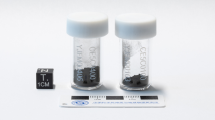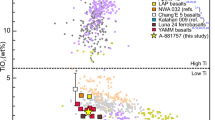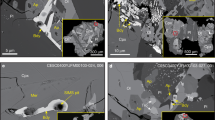Abstract
Primordial solidification of the Moon (or its uppermost layer) resulted in the formation of a variety of rock types that subsequently melted and mixed to produce the compositional diversity observed in the lunar sample suite1,2. The initial rocks to crystallize from this Moon-wide molten layer (the magma ocean) contained olivine and pyroxene and were compositionally less evolved than the plagioclase-rich rocks that followed. The last stage of crystallization, representing the last few per cent of the magma ocean, produced materials that are strongly enriched in incompatible elements including potassium (K), the rare earth elements (REE) and phosphorus (P)—termed KREEP3,4,5. The decay of radioactive elements in KREEP, such as uranium and thorium, is generally thought to provide the thermal energy necessary for more recent lunar magmatism4,6,7. The ages of KREEP-rich samples are, however, confined to the earliest periods of lunar magmatism between 3.8 and 4.6 billion years (Gyr) ago8,9, providing no physical evidence that KREEP is directly involved in more recent lunar magmatism. But here we present evidence that KREEP magmatism extended for an additional 1 Gyr, based on analyses of the youngest dated lunar sample.
This is a preview of subscription content, access via your institution
Access options
Subscribe to this journal
Receive 51 print issues and online access
$199.00 per year
only $3.90 per issue
Buy this article
- Purchase on Springer Link
- Instant access to full article PDF
Prices may be subject to local taxes which are calculated during checkout



Similar content being viewed by others
References
Wood, J. A., Dickey, J. S., Marvin, U. B. & Powell, B. N. Lunar anorthosites and a geophysical model of the Moon. Proc. 1st Lunar Planet. Sci. Conf. 965–988 (Pergamon, New York, 1970)
Smith, J. A., et al. Petrologic history of the Moon inferred from petrography, mineralogy, and petrogenesis of Apollo 11 rocks. Proc. 1st Lunar Planet. Sci. Conf. 1149–1162 (Pergamon, New York, 1970)
Snyder, G. A., Taylor, L. A. & Neal, C. R. A chemical model for generating the sources of mare basalts: Combined equilibrium and fractional crystallization of the lunar magmasphere. Geochim. Cosmochim. Acta 56, 3809–3823 (1992)
Warren, P. H. & Wasson, J. T. The origin of KREEP. Rev. Geophys. Space Phys. 17, 73–88 (1979)
Warren, P. H. The origin of pristine KREEP: Effects of mixing between urKREEP and the magmas parental to the Mg-rich cumulates. Proc. 8th Lunar Planet. Sci. Conf. 233–241 (1988)
Hess, P. C. & Parmentier, E. M. Thermal evolution of a thicker KREEP liquid layer. J. Geophys. Res. 106, 28023–28032 (2001)
Wieczorek, M. A. & Phillips, R. J. The “Procellarum KREEP Terrane”: Implications for mare volcanism and lunar evolution. J. Geophys. Res. 105, 20417–20430 (2000)
Nyquist, L. E. & Shih, C.-Y. The isotopic record of lunar volcanism. Geochim. Cosmochim. Acta 56, 2213–2234 (1992)
Snyder, G. A., Borg, L. E., Nyquist, L. E. & Taylor, L. A. in Chronology and Isotopic Constraints on Lunar Evolution (eds Canup, R. & Righter, K.) 361–395 (Univ. Ariz. Press, Tucson, 2000)
Fagan, T. J. et al. Northwest Africa 773: Lunar origin and iron-enrichment trend. Meteorit. Planet. Sci. 38, 529–554 (2003)
Jolliff, B. L., Korotev, R. L., Zeigler, R. A. & Floss, C. Northwest Africa 773: Lunar mare breccia with a shallow-formed olivine-cumulate component, very low Ti (VLT) heritage and a KREEP connection. Geochim. Cosmochim. Acta 67, 4857–4879 (2003)
Borg, L. E., Nyquist, L. E., Weismann, H., Shih, C.-Y. & Reese, Y. The age of Dar al Gani 476 and the differentiation history of the martian meteorites inferred from their radiogenic isotopic systematics. Geochim. Cosmochim. Acta 67, 3519–3536 (2003)
Ludwig, K. J. R. Users Manual for Isoplot/Ex v. 2.49: A Geochronological Toolkit for Microsoft Excel (Berkeley Geochronology Center Special Publication No. 1a, BGC, Berkeley, 2001) 〈http://www.bgc.org/klprogrammenu.html〉
Fernandes, V. A., Burges, R. & Turner, G. 40Ar-39Ar chronology of lunar meteorites Northwest Africa 032 and 773. Meteorit. Planet. Sci. 38, 555–564 (2003)
Hiesinger, H., Head, J. W., Wolf, U., Jaumann, R. & Neukum, G. Ages and stratigraphy of mare basalts in Oceanus Procellarum, Mare Nubium, Mare Cognitum, and Mare Insularum. J. Geophys. Res. 108, 1–27 (2003)
Nyquist, L. E., Bansal, B. M., Wooden, J. L. & Wiesmann, H. Sr-isotopic constraints on the petrogenesis of Apollo 12 basalts. Proc. 8th Lunar Planet. Sci. Conf. 1383–1415 (Pergamon, New York, 1977)
Papanastassiou, D. A. & Wasserburg, G. J. Rb-Sr age of troctolite 76535. Proc. 7th Lunar Sci. Conf. 2035–2054 (Pergamon, New York, 1976)
Shih, C.-Y. et al. Age of pristine noritic clasts from lunar breccias 15445 and 15455. Geochim. Cosmochim. Acta 57, 915–931 (1993)
Warren, P. H. in Workshop on Moon in Transition: Apollo 14, KREEP, and Evolved Lunar Rocks 149–153 (LPI Technical Report 98–03, Lunar and Planetary Institute, Houston, 1989)
Shih, C.-Y., Nyquist, L. E., Bansal, B. M. & Weismann, H. Rb-Sr and Sm-Nd chronology of an Apollo 17 KREEP basalt. Earth Planet. Sci. Lett. 108, 203–215 (1992)
Hughes, S. S., Delano, J. W. & Schmitt, R. A. Apollo 15 yellow-brown glass: Chemistry and petrogenetic relations to green volcanic glass and olivine-normative basalts. Geochim. Cosmochim. Acta 52, 2379–2391 (1988)
Snyder, G. A., Taylor, L. A. & Halliday, A. N. Chronology and petrogenesis of the lunar highlands alkali suite: Cumulates from KREEP basalt crystallization. Geochim. Cosmochim. Acta 59, 1185–1203 (1995)
Snyder, G. A., Neal, C. R., Taylor, L. A. & Halliday, A. N. Processes involved in the formation of magnesian-suite plutonic rocks from the highlands of the Earth's moon. J. Geophys. Res. 100, 9365–9388 (1995)
Dash, E. J. et al. Time of crystallization of a unique A15 basalt. Lunar Planet. Sci. Conf. XX, 218–219 (1989)
Acknowledgements
We thank L. Nyquist for the use of his heavy liquid separations facility at the Johnson Space Center, M. Grady and S. Russell of the Natural History Museum, London for providing us with the sample, and two anonymous reviewers for their comments. This work was supported by NASA Cosmochemistry Program.
Author information
Authors and Affiliations
Corresponding author
Ethics declarations
Competing interests
The authors declare that they have no competing financial interests.
Rights and permissions
About this article
Cite this article
Borg, L., Shearer, C., Asmerom, Y. et al. Prolonged KREEP magmatism on the Moon indicated by the youngest dated lunar igneous rock. Nature 432, 209–211 (2004). https://doi.org/10.1038/nature03070
Received:
Accepted:
Issue Date:
DOI: https://doi.org/10.1038/nature03070
This article is cited by
-
Surges in volcanic activity on the Moon about two billion years ago
Nature Communications (2023)
-
The magmatic architecture and evolution of the Chang’e-5 lunar basalts
Nature Geoscience (2023)
-
Spectral interpretation of late-stage mare basalt mineralogy unveiled by Chang’E-5 samples
Nature Communications (2022)
-
Large impact cratering during lunar magma ocean solidification
Nature Communications (2021)
-
Two-billion-year-old volcanism on the Moon from Chang’e-5 basalts
Nature (2021)
Comments
By submitting a comment you agree to abide by our Terms and Community Guidelines. If you find something abusive or that does not comply with our terms or guidelines please flag it as inappropriate.



